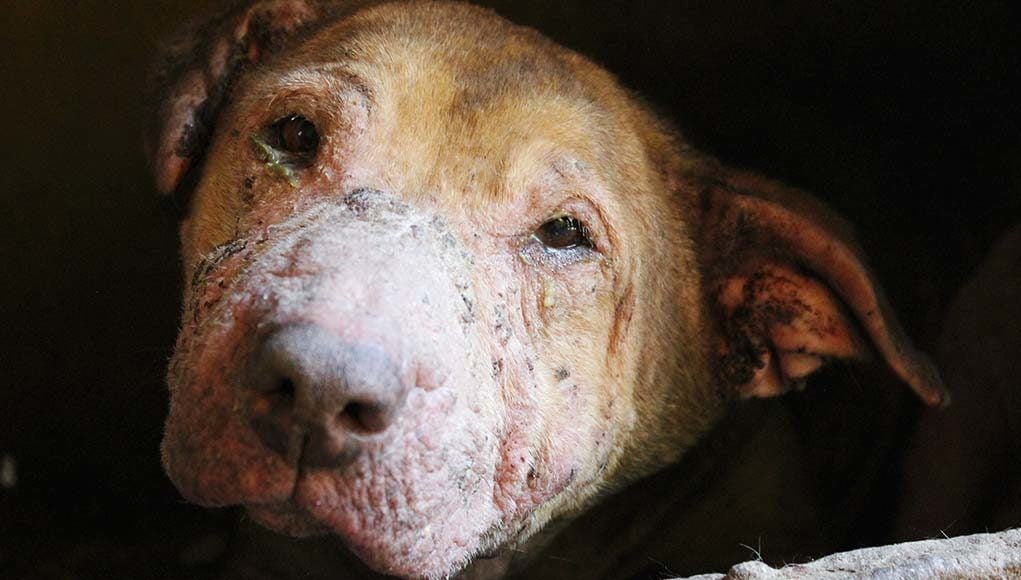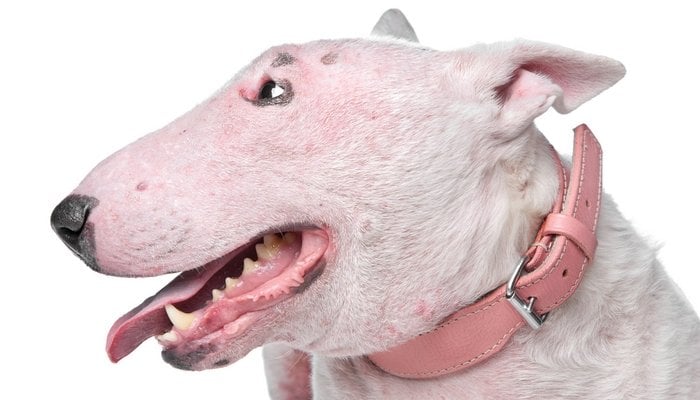Most dog skin conditions are minor, but they can be uncomfortable for the dog when left untreated.
Some other dog skin problems are related to serious infections, and the treatment will be more complicated.
If you notice your pet scratching or chewing its skin more than normal, this may be the first symptom of your dog's skin condition.
Common Dog Skin Conditions and Their Treatment Options
1. Atopic Dermatitis
This is a chronic, inflammatory condition that affects the dog's skin.
It cannot be cured, and lifelong management is required. But a study published in 2021 is showing promising results that could make a change in this area.
Atopic Dermatitis (AD) is a genetically predisposed condition caused by environmental allergens: pollen, cleaning sprays, and mold (1, 2).
This condition will most often show up on a dog's face, ears, underarms, lower legs, and paws (3, 4).
Atopic Dermatitis in dogs is very common and can be difficult to deal with (5, 6, 7).
It may begin as the odd scratch here and there, then cultivate into your dog rubbing themselves raw, making the condition much worse.
By itself, it may also gradually get worse if there's no treatment provided.
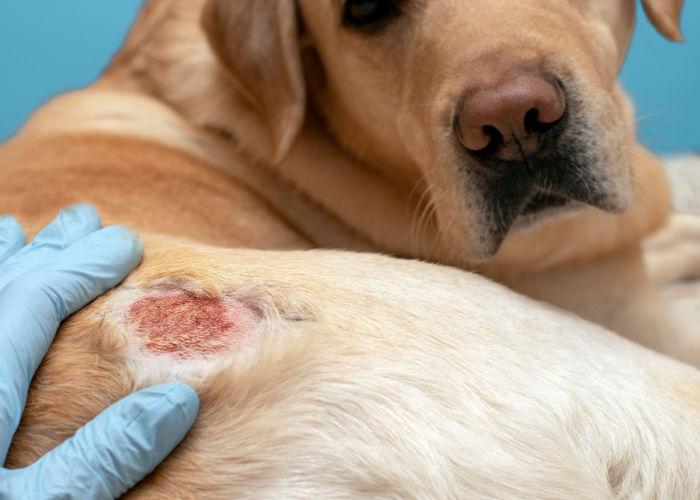
Symptoms
- Itching and scratching excessively
- Rubbing against furniture or trees
- Licking at the affected area
Home Remedies
Apple Cider Vinegar – Combine one part ACV with one part water in a sterile spray bottle and spray on the affected areas to relieve itching and help encourage healing.
If your dog has raw areas of skin, it's best to use a milder option, as this could sting.
Air Purifier – An excellent way to get rid of environmental pollutants like dust is to run an air purifier where your dog spends most of his time.
Many owners swear by this solution and claim that the difference in their pet's quality of life and skin health improves beyond belief!
Veterinary Treatment Options
As this is an allergy-based condition, blood testing, and skin patch testing are usually performed to determine the allergen that's causing your dog to have outbreaks.
Your veterinarian may send you to a specialist canine dermatologist to find the source and develop an effective treatment plan.
The treatment of Atopic Dermatitis in dogs must be multifaceted. Different interventions will most likely be combined for the most optimal benefit to a dog (7, 8, 9).
- Hyposensitization Therapy
- Corticosteroids
- Antihistamines
- Immunosuppressants
- Topical ointments
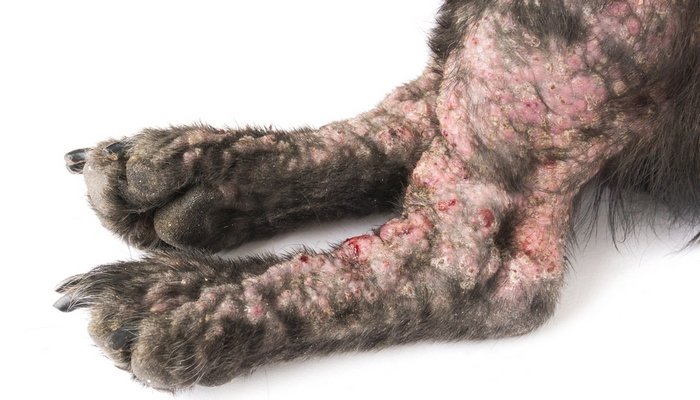
2. Pemphigus
This is a group of four autoimmune skin conditions that cause scabs, crusting and fluid-filled cysts on the dog's skin (10, 11). Bacterial infections from open sores, fever, and depression are common.
Each variation of Pemphigus shows different effects and symptoms (12). They are:
Vegetans – This is characterized by groupings of cysts that bond together to form large oozing skin lesions.
Foliaceus – This variation mostly affects a dog's head, ears, and paws.
Symptoms are scabbing, crusting of the skin, oozing lesions, and overgrowth on the pads of the feet, which result in a cracked appearance.
As the dog's feet are affected, the pet will suffer from mild to severe lameness, running a fever, and swelling on the lymph nodes.
Erythematosus – Similar in symptoms to Pemphigus Foliaceus, the main way to distinguish the difference is by looking at the color of the dog's lips.
If the lips are turning pale or blueish, Erythematosus is likely the culprit.
Vulgaris – The most severe variation of Pemphigus, blisters, and deep ulcers will likely appear across the entire body.
Mouth ulcers are a huge problem with this ailment.
The pain can stop a dog from eating and result in anorexia which weakens the body's immune response further.
Home Remedies
Changes in your dog's diet may be beneficial as autoimmune conditions are greatly affected by it.
Diet can also help to alleviate and overcome symptoms.
Consult with a vet because each dietary choice will be specific.
Veterinary Treatment Options
In each of the above four variants, as with all autoimmune conditions, the body is reacting with healthy tissue as though it were a threat (13, 14).
Your veterinarian will perform a skin analysis to ensure that there aren't other reasons for the symptoms. Once a positive diagnosis has been made, treatment can begin.
The standard treatment process for canines suffering from Pemphigus is steroid therapy and the use of topical treatments (15, 16).
In more severe cases, the dog will need to be hospitalized for a period to safely get the symptoms under control.
Corticosteroid therapy is another treatment for these skin problems. It will require your pet to switch to a low-fat diet due to its proclivity to increase the risk of pancreatitis.
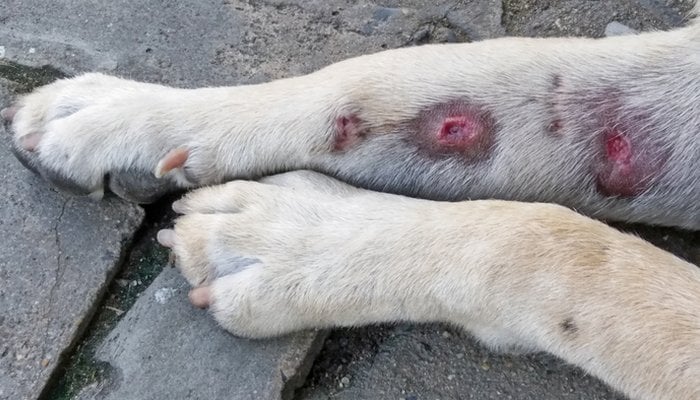
3. Hot Spots (Pyotraumatic Dermatitis)
These annoying yet mos minor skin irritations on your dog can be likened to heat rash we can get during the summer (17, 18).
Also known as summer sores or acute moist dermatitis, they are most often caused by gnawing or licking at an area which results in bacterial infections.
All dogs have healthy bacteria living on their skin.
But when they pierce the surface, even with just a tiny scrape, that normal bacteria makes its way into the dog's body. This will then create a skin infection which can cause oozing sores.
Most commonly, these issues happen in humid climates or after your dog has been in the water.
Acute moist dermatitis is more common in dogs with thick undercoats, such as Border Collies, Labradors, German Shepherds, and Golden Retrievers.
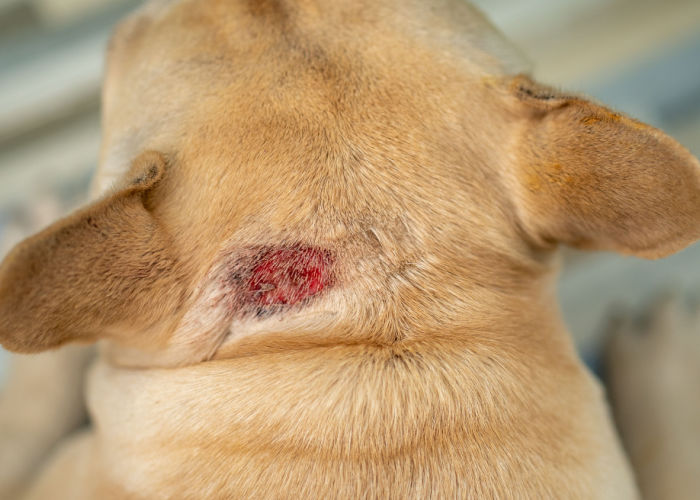
Symptoms
The hot spot itself is the first sign!
So when you spot a raised or oozing bump on your dog's skin, it's best to take him for immediate medical treatment before it worsens.
Home Remedies
The best way to aid in recovery and avoid hotspots is to keep your dog's fur well-groomed and trimmed.
If you live in hot or humid weather, this is of particular importance.
While your dog is recovering from this ailment, you can gently wash the area with mild shampoo and pat the dog dry.
Many veterinarians will advise that your dog wears a recovery cone during the initial healing process to avoid reopening the healing wound.
Veterinary Treatment Options
The main treatment for this condition is cleaning the area, sometimes washing the dog using a medicated shampoo, and following with the application of a topical ointment (19, 20, 21).
Depending on the severity of the bacterial infection, your veterinarian may also prescribe oral antibiotics.
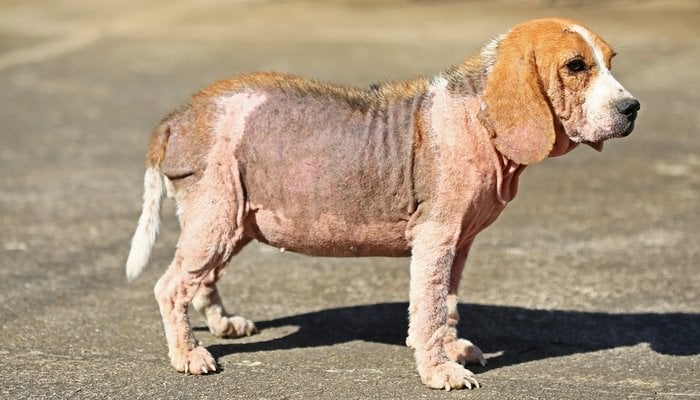
4. Sarcoptic Mange
Sarcoptic mange, also known as canine scabies, is caused by the sarcoptic mite taking up residence atop your pooch.
It's a common condition highly contagious to canines, humans, and wildlife (22, 23, 24). It's advised that you keep your dog quarantined while treatment takes place.
Your dog can easily pick this up from a boarding kennel, at the dog park, or at your local vet clinic.
The condition takes about six weeks post-exposure to show symptoms. Once developed, it can affect not only the skin but a dog's internal organs, too (25).
The sarcoptic mite (also known as the Sarcoptes Scabie Mite) burrows into your dog's skin and will cause irritation and itching for your poor pup (26).
Contrary to popular belief, the mite itself doesn't cause the dog's hair to fall out. Rather, it's your dog's scratching of his itchy skin that results in hair loss.
Symptoms
- Excessive itching of the skin
- Areas of bleeding on the skin
- Scabs forming on the skin
- Hair loss
- Raised rash
Home Remedies
Use scabicidal shampoo on your dog once per week until every sign of the mite has gone and your vet has given him the all-clear.
And because this skin condition is highly contagious to humans, it might be worth picking up a scabicidal shampoo for yourself too!
Veterinary Treatment Options
The treatment for the sarcoptic mange itself is simple: the dog is ordinarily given a scabicide dip that kills all living mites on the body.
Over-the-counter dry skin remedies can also be used to alleviate further discomfort (27, 28, 29).
It's worth noting that this doesn't kill the eggs. Hence, a weekly bath with a medicated shampoo at home is necessary in most cases.
The secondary problem of possible skin infections will be treated with topical treatments and may also include steroids if advised by a vet.
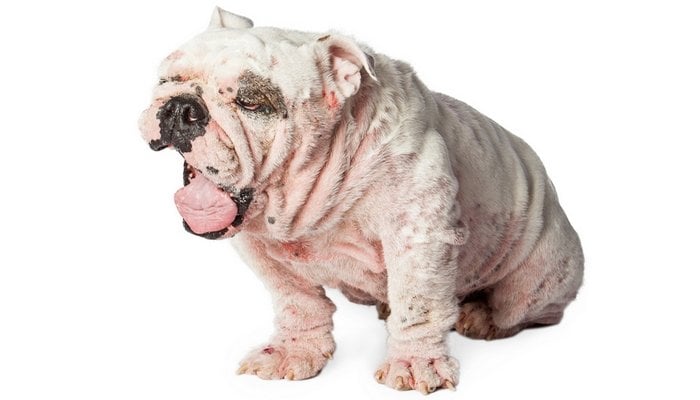
5. Demodectic Mange
Demodectic mange, unlike the Sarcoptic variety, is caused by an influx of overpopulation of Demodex mites that ordinarily live on dogs without issue (30, 31, 32).
This usually occurs in dogs that carry a Demodex mite and have a weakened immune system, including sick or old dogs (33, 34).
Symptoms

The symptoms of the condition include:
- Lesions on the body
- Excessive itching
- Hair loss
Home Remedies
Unlike other dog skin problems, studies show that homeopathic remedies can help with Demodectic Mange (35).
Soothing the irritation is your goal during your pet's recovery.
You can do this by bathing them in a mild soap regularly and applying a fresh aloe vera gel to the afflicted area of your dog's skin afterward.
Use a cone collar or inflatable collar after application to avoid your dog from licking and causing even more damage.
Medical Treatment
In most cases, dog skin problems like mange will resolve by themselves.
For other cases, treatments may include amitraz rinses, oral ivermectin, milbemycin, and moxidectin. A lime-sulfur dip may be required to help control the Demodex population (36, 37, 38).
Different topical treatments and spot-on formulations, such as those with 10% imidacloprid and 2.5% moxidectin, have also been successfully used for treatment with no side effects (39).
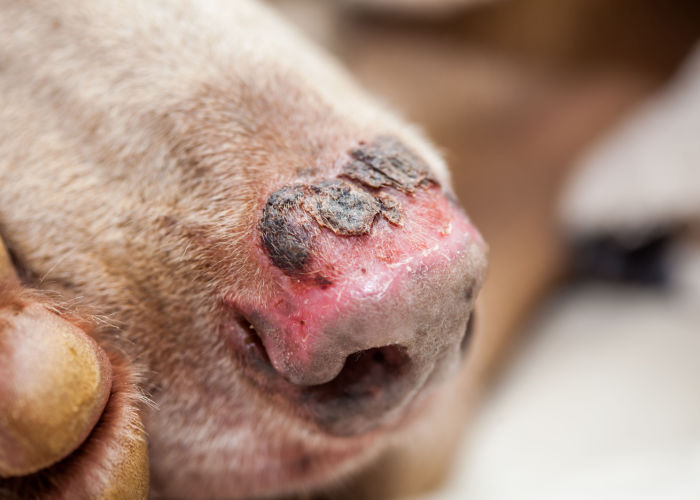
6 Sunburn
Sunburn condition is often overlooked when it comes to dogs, but some breeds are just as likely to get sunburned.
They're even more susceptible to getting dry skin, especially in the summertime.
Even though we humans remember to slather sunscreen on ourselves, you may well be forgetting to protect your beloved pet, and most aren't even aware that dog sunscreens exist, too.
The most common areas to be affected by sunburn are the dog's face and ears. Shorter-haired dogs are more susceptible to sunburn all over their body.
Symptoms
- Dry skin
- Red skin
- Peeling, flaky skin
- Painful blisters
Home Remedies
The best cure is prevention from sunburn, but you cannot use human sunscreens on your pet.
Zinc oxide, which is an ingredient in most sunscreens, can cause severe and sometimes deadly results if ingested by your dog.
Use dog-friendly sunscreen instead – they are available to buy at many pet stores and online.
If you can't find a pet-friendly option, sometimes it is possible to use baby sunscreen, but make sure that it's fragrance-free and doesn't contain zinc oxide.
Veterinary Treatment Options
To relieve pain, your vet will likely apply cold compresses to the affected skin and cortisone to reduce inflammation.
And to prevent bacterial skin infections from occurring, your vet may prescribe an antibacterial ointment.
If your pooch does develop an infection after suffering from sunburn, you can request antibiotics from your vet to help to clear it up pretty quickly.
Studies have shown indomethacin to be effective at treating sunburn in dogs (40).

FAQs on Dog Skin Conditions
What can I feed my dog with skin problems?
Fish with Omega-3 oil is the best food to reduce inflammation which can help manage your dog's skin problems.
You can also give him supplements like fish oil or coconut oil to improve the health and appearance of your dog's coat.
How to spot a pet with a skin condition?
If you see your pet excessively licking or scratching a certain body part, there might be something on it that makes it itchy.
Other visual signs your dog may have skin problems are hair loss, red, flaky skin, or a change in texture.
Dog Skin Conditions – Summary
When your dog shows signs of any skin disease, seek out veterinary care immediately for a proper diagnosis.
The immediate care of any dog skin conditions will likely save your pet from pain. It will also save you from larger vet bills should things be left to progress.
Once a particular dog skin condition has been accurately diagnosed, the rest is plain sailing back to healthy skin.
A clear treatment plan usually includes routine bathing, ointment application, and, sometimes, oral antibiotics.
Follow your veterinarian's instructions exactly, and don't miss any treatments if at all possible.
READ NEXT: 7 Best Dog Skin Infection Treatments (OTC)


